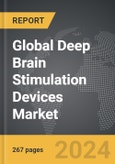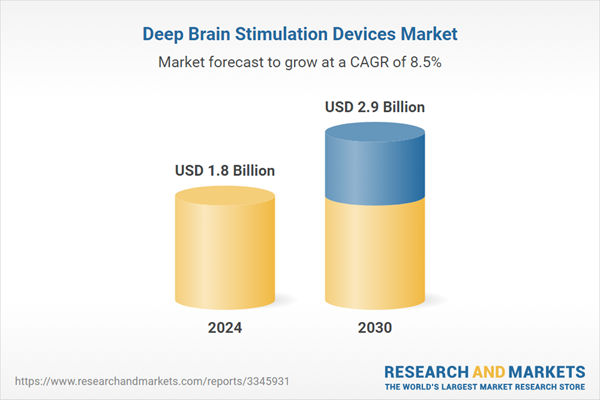Global Deep Brain Stimulation Devices Market - Key Trends and Drivers Summarized
Deep Brain Stimulation (DBS) devices have become transformative in treating neurological disorders such as Parkinson's disease and essential tremor, significantly enhancing patient quality of life. This advanced technology operates by implanting a device that sends electrical signals to targeted brain areas to regulate abnormal impulses. The device, likened to a pacemaker for the brain, includes a pulse generator implanted under the skin of the chest and leads that extend to the brain, delivering electrical impulses that can be adjusted remotely or directly by specialists. Recent advancements have improved the precision of these devices through intraoperative imaging, which allows for exact placement of electrodes, enhancing treatment efficacy and minimizing side effects. Further innovations include bidirectional DBS systems, which not only deliver therapeutic stimulation but also adapt to the patient's changing neurological conditions, offering personalized treatment that evolves with the patient's needs.The development and utilization of DBS devices are witnessing dynamic growth, propelled by several factors. Increasing prevalence of neurological disorders, such as Parkinson’ s and dystonia, heightens the demand for effective and minimally invasive treatment solutions like DBS. Technological advancements in neurotechnology, including enhanced imaging techniques and surgical tools, have improved the precision and effectiveness of DBS implantations. Furthermore, a shift toward minimally invasive procedures appeals to patient preferences, promoting quicker recoveries and reduced surgical risks. Improved patient outcomes through DBS have been well-documented, adding to its appeal. Regulatory support, particularly from bodies like the FDA and EMA, further legitimizes the technology and encourages its adoption. The healthcare sector's increasing investment in neurological disorders and broader insurance coverage for advanced neurotherapies also significantly contribute to the widespread use of DBS.
The future of DBS devices looks promising, driven by continuous research and the integration of cutting-edge technologies like artificial intelligence (AI) and machine learning, which enhance device functionality by optimizing stimulation patterns based on real-time brain activity. Collaborative efforts in research and development among academic institutions, hospitals, and industry leaders are crucial in innovating more sophisticated DBS solutions. The aging global population and a consequent rise in age-related neurological conditions also predict a growing need for effective DBS treatments. Additionally, expanding indications for DBS to include psychiatric and other neurological conditions broadens its applicability, increasing the potential patient base. Governmental support and economic incentives for medical technology innovation further stimulate advancements and adoption of DBS technologies. As such, DBS devices are set to play an increasingly vital role in neurotherapeutic interventions, potentially transforming the landscape of treatment for a broad spectrum of neurological disorders.
Report Scope
The report analyzes the Deep Brain Stimulation Devices market, presented in terms of market value. The analysis covers the key segments and geographic regions outlined below.- Segments: Product Type (Dual-Channel, Single-Channel); Application (Parkinson's, Pain Management, Epilepsy, Essential Tremors, Depression, Obsessive Compulsive Disorder (OCD), Other Applications); End-Use (Hospitals, Neurology Clinics, Ambulatory Surgery Centers, Research Centers).
- Geographic Regions/Countries: World; United States; Canada; Japan; China; Europe (France; Germany; Italy; United Kingdom; Spain; Russia; and Rest of Europe); Asia-Pacific (Australia; India; South Korea; and Rest of Asia-Pacific); Latin America (Argentina; Brazil; Mexico; and Rest of Latin America); Middle East (Iran; Israel; Saudi Arabia; United Arab Emirates; and Rest of Middle East); and Africa.
Key Insights:
- Market Growth: Understand the significant growth trajectory of the Dual-Channel Devices segment, which is expected to reach US$1.7 Billion by 2030 with a CAGR of a 8.1%. The Single-Channel Devices segment is also set to grow at 9% CAGR over the analysis period.
- Regional Analysis: Gain insights into the U.S. market, valued at $467.7 Million in 2024, and China, forecasted to grow at an impressive 12.4% CAGR to reach $740.5 Million by 2030. Discover growth trends in other key regions, including Japan, Canada, Germany, and the Asia-Pacific.
Why You Should Buy This Report:
- Detailed Market Analysis: Access a thorough analysis of the Global Deep Brain Stimulation Devices Market, covering all major geographic regions and market segments.
- Competitive Insights: Get an overview of the competitive landscape, including the market presence of major players across different geographies.
- Future Trends and Drivers: Understand the key trends and drivers shaping the future of the Global Deep Brain Stimulation Devices Market.
- Actionable Insights: Benefit from actionable insights that can help you identify new revenue opportunities and make strategic business decisions.
Key Questions Answered:
- How is the Global Deep Brain Stimulation Devices Market expected to evolve by 2030?
- What are the main drivers and restraints affecting the market?
- Which market segments will grow the most over the forecast period?
- How will market shares for different regions and segments change by 2030?
- Who are the leading players in the market, and what are their prospects?
Report Features:
- Comprehensive Market Data: Independent analysis of annual sales and market forecasts in US$ Million from 2024 to 2030.
- In-Depth Regional Analysis: Detailed insights into key markets, including the U.S., China, Japan, Canada, Europe, Asia-Pacific, Latin America, Middle East, and Africa.
- Company Profiles: Coverage of players such as Advanced Micro Devices, Inc., AppReal-VR, Barco N.V, Crytek GmbH, Cubicle Ninjas and more.
- Complimentary Updates: Receive free report updates for one year to keep you informed of the latest market developments.
Some of the 29 companies featured in this Deep Brain Stimulation Devices market report include:
- Abbott Laboratories
- Aleva Neurotherapeutics SA
- Beijing PINS Medical
- Boston Scientific
- Medtronic
- SceneRay
This edition integrates the latest global trade and economic shifts into comprehensive market analysis. Key updates include:
- Tariff and Trade Impact: Insights into global tariff negotiations across 180+ countries, with analysis of supply chain turbulence, sourcing disruptions, and geographic realignment. Special focus on 2025 as a pivotal year for trade tensions, including updated perspectives on the Trump-era tariffs.
- Adjusted Forecasts and Analytics: Revised global and regional market forecasts through 2030, incorporating tariff effects, economic uncertainty, and structural changes in globalization. Includes historical analysis from 2015 to 2023.
- Strategic Market Dynamics: Evaluation of revised market prospects, regional outlooks, and key economic indicators such as population and urbanization trends.
- Innovation & Technology Trends: Latest developments in product and process innovation, emerging technologies, and key industry drivers shaping the competitive landscape.
- Competitive Intelligence: Updated global market share estimates for 2025, competitive positioning of major players (Strong/Active/Niche/Trivial), and refined focus on leading global brands and core players.
- Expert Insight & Commentary: Strategic analysis from economists, trade experts, and domain specialists to contextualize market shifts and identify emerging opportunities.
Table of Contents
Companies Mentioned (Partial List)
A selection of companies mentioned in this report includes, but is not limited to:
- Abbott Laboratories
- Aleva Neurotherapeutics SA
- Beijing PINS Medical
- Boston Scientific
- Medtronic
- SceneRay
Table Information
| Report Attribute | Details |
|---|---|
| No. of Pages | 267 |
| Published | January 2026 |
| Forecast Period | 2024 - 2030 |
| Estimated Market Value ( USD | $ 1.8 Billion |
| Forecasted Market Value ( USD | $ 2.9 Billion |
| Compound Annual Growth Rate | 8.5% |
| Regions Covered | Global |









